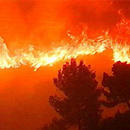|
|
 |
|
|
|
 |
| |
|
|
 |
Food & Climate
Basics |
Drought and fire
Many scientists affirm that as a consequence of a climate change, there would be an increase in the number, severity and seasonal distribution of forest fires related to the changes in precipitation and temperature.
|
|
|
|
|
 |
During the 1990s in tropical humid areas, major fires have occurred in the Brazilian Amazon, Mexico and Indonesia, and were particularly severe during El Niño episodes, associated with a significant drought over much of these regions.
Which are the main factors for a fire burst?
· Presence of Fuels.
· Low moisture levels.
· Winds
|
 |
 |
 |
|
1. Forest fire in Portugal. 2003
EUROPA-PRESS
|
|
|
In a world affected by climate change there would be an increase of extreme events, as we have mentioned before, and the difference between dry and wet seasons would be much larger. The wet seasons would probably affect vegetation productivity increasing it, as plants would have enough water for their development. This increase in productivity also means an increase in potential fuel. Dry seasons, on the other hand, would force a high evaporation rate that would dry up all forest fuels (trees, and other plants and organic matter), and probably increase mortality. the final consequence of this would be the generation of a big amount of material extremely inflamable.
|
|
In certain areas of the world there is no need of climate change for meeting these conditions, as they are easily found out in places like the Mediterranean, where winters are cold and rainy while summers are very hot and dry.
As you see in these maps (2. Changes in temperature and precipitation in Europe during the summer of 2003) this is exactly the case of what happened in Europe during the 2003 summer. Precipitation levels were as low as the 50% of the normal level, and at the same time temperatures were higher than normal summers. The dryness of forest fuels created the perfect scene for fire and during two months a great extension in Portugal (around 325000 ha, bigger than Luxemburg) and Spain was burnt with no possibility of action.
|
 |
 |
|
2. Changes in temperature and precipitation in Europe during the summer of 2003
Source. NOAA
|
|
Climate change could be an important factor in the increase of forest fires, but actually it is not the main one, as 95% of the fires in the Mediterranean region are caused by human activities, some of them intentionally and some of them not, but when all these factors meet, fires are very hard to put out and they brush away the ecological variety of land.
Fires are part of the natural seasonal cycle of forest growth, but the IPCC has listed a number of places with a significant increase in fire activity in the last decade, which exceeds this explanation of natural cycles.
Fire frequency is expected to increase with human-induced climate change, specially in those places where precipitation is reduced or remains the same. The use of models has also suggested the increase in risk, frequency and severity of fires in Europe.
The most direct consequences of this change in fire patterns will be the change in structure and composition of forests, land use patterns and emissions to the atmosphere (which have already been mentioned in the “Lower atmosphere” unit)
|
Author: Marta Moneo and Ana Iglesias- Universidad Politécnica de Madrid - España
1. Scientific reviewer: Alex de Sherbinin - CIESIN, Columbia University - USA
2. Scientific reviewer: Lily Parshall - Goddard Institute for space studies, Columbia University - USA
Educational reviewer: Emilio Sternfeld - Colegio Virgen de Mirasierra - España
Last update: 12/05/2004 |
|
 |
|









